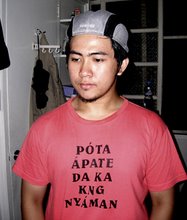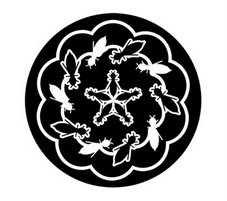Kapampangans then used what researchers call Kulitan or Baybayin Kapampangan. The writing style is closer to most Asian writings such as Brahmic and Chinese, including the vertical way of writing instead of horizontal.
A lot of us complain that it's very tedious writing in Filipino because words are so long. Well, that's because our natural way of spelling our own words is not in Roman alphabets. It's actually quicker to write native words using our native script. Writing "KAPAMPANGAN" for instance would require 11 characters from the Roman alphabet. In Kulitan, just seven. Seven Kulitan characters for MAKAPAGTAKA, 11 from Roman alphabet.
So how could I live without knowing how to write in Kulitan?!

In fact, I got myself a henna tattoo a while ago in a beach resort in Olongapo (we visited my father-side uncles and aunt) that reads "Kapampangan." Of course, the artist had no idea how to write the word, since all of his character templates are Chinese, Japanese, etc. I wrote the word myself and had him transfer it to my unevenly colored arm a la 'Flame of Recca'.
If you wish to learn it, I can gladly teach you. Just send me an email. In case you haven't noticed yet, the vertical writing in my blog's banner is how you write KAMARU using Kulitan. Cool, ne?

Susug: Check out my father-side pisan (cousin). He acts timid when you ask him to be photographed, but once you aim the camera, he acts Mr. Pogi faster than lightning. Sadly, he will grow up a Tagalog since his parents talk to him in Tagalog in spite of his being a Kapampangan.
Anyway, check out my Kamaru shirt. It actually reads "Mulala, oyni ing singsing mung mebating" (Stupid, here's the ring that you lost). My father-side relatives quickly knew that the statement was referring to the singsing lost in the folk song Atin Ku Pung Singsing. I wonder if the rest of the Kapampangans in that beach resort (there were a lot!) knew that, too.








15 comments:
Casalese na niyan Capatad, Actually abanggit at apaquit na ne canitang Talaturung Suiala ning meangubie yan canita.Acu rin, buri que sanang palaganapan mu naman yan.
Dacal tuligsa qng pamañulat ta'ng matua uling na qñg taliuas ya qñg pamamaralan rang pamañulat da ring aliua ta'ng siping bale. (Anti na reng Tagalug caili-wanan mo canu susulat ngara pero me-impluensiyan nalang paralan Castila.)
Yniang minta cu U.P. Diliman, menaquit cung duquit qñg batung maqui-duquit "Ethnic" at yquit cu na atin la naman quebit "alibata" da ring Tagalug. Sana mo atin mu naman magaua anti cañan queti balen. Acaquit cu sanang masanting a paglugalan na, qñg P.A.C. qñg Magalañg.
Angga na queti Capatad. Magluid ngan sana reng balac mung mayap.
Eduardo John A. Balatbat
TaramPalat Balatbat tauculiat ning babo Abacan.
Mañauad cung dispensa: Erratum:
Laguiu ning Mayap ming (cung) Talaturu oyne: "Siuala ning Meangubie" at ali
Suiala ning meangubie.
Dispensa pu.
Lubus a gagalang
Eduardo John A. Balatbat
TaramPalat Balatbat tauculiat ning babo Abacan.
Of course, what a great site and informative posts, I will add backlink - bookmark this site? Regards, Reader.
Jason, Papa Osmubal here, and I have to tell you I like your article (and am using part of it in my site's header info). But one thing I have to tell you (in all honesty) is that kulitan/baybayin/alibata is totally different from Chinese. Chinese characters are not symbols, they are pictures-- each character tells a story. I mean looking at a chinese character is totally like looking at a picture or a painting-- you see things in there and those things tell stories, and therefore meanings. I hope this information will help you later on next time you write about these languages (kapampangan and chinese). Or maybe you may want to edit your article and re-post it with the information I presented here.
Best,
Papa Osmubal
Hello Papa Osmubal,
If you read my article carefully, I never said Baybayin was TOTALLY LIKE Chinese. I just said it's closer to it [compared to Roman Alphabets].
Regards
Hi Jason,
Bro, I am sorry for that gaffe. What I really mean is it is NOT EVEN CLOSER to Chinese. Maybe, bro, what you mean by CLOSER is that they are not romanized. That is all their similarity-- that they are not romanized, nothing more than that. Because chinese is a 'pictorial' language, while Kulitan/Baybayin/Alibata are just like letters of the alphabets, they are just 'symbolic', they are not pictorial. I would have agreed if you said Kulitan/Alibata/Baybayin are closer to Japanese, Thai, Korean, Vietnamese, Cambodian and languages like those, 'coz those are 'symbolic' like roman alphabets, one symbol represents a letter or sound, and that is not the case in Chinese. I hope you got what I mean there, bro.
Peace, knowledge and power,
from your kabalen Papa Osmubal
I dont know how to use the Diacritic in Sulat Kapampangan, can you make a Blog for tutorial
Hi Sir,
I like this article very much. Dakal a Salamat. I never thought that Kapampangans were really this advanced even before the Spaniards came.
Literacy rate in Korea is really high because they still use their Hangeul ancient alphabet even today. Hope that Kulitan alphabet could be learned by Kapampangan even for cultural purposes only.
I wish I could learn Kulitan as I don't want to forget the culture of my roots. I was raised in Manila but my mother is a native Kapampangan from Concepcion, Tarlac.
I will appreciate nanu mang saup ing abiye mu.
Salamat Kabalen.
ayni pala ing email ku..
18tolentino@gmail.com
This blog was... how do I say it? Relevant!! Finally I've found something which helped me. Appreciate it!
Feel free to surf my web-site free clickbank products
It's fantastic that you are getting ideas from this piece of writing as well as from our argument made at this place.
Here is my web site - get home equity loan
Hi to every body, it's my first pay a visit of this web site; this weblog includes amazing and really good material designed for readers.
Feel free to visit my blog :: krankenversicherung vergleich gesetzliche
Wow, this piece of writing is fastidious, my younger sister is analyzing
these things, thus I am going to inform her.
my website - affiliate programs
Wow, this piece of writing is fastidious, my younger sister is analyzing these things, thus I am going to inform her.
Stop by my page :: affiliate programs
Hi kabalen.
I'm also a fan of the kulitan writing system. Just wondering, is there a modernized version of the system. I've seen people write the cha, ja, and za sound but not sure if they're official. I've ordered the book Introduction to Kulitan and can't wait to read it. If you have any info on this subject please let us know. Much appreciated.
From a loyal kapampangan in Australia.
I wrote several articles on the same topic, but it seems to know a bit far more than I do.
My web page: tarife private krankenversicherung
Post a Comment